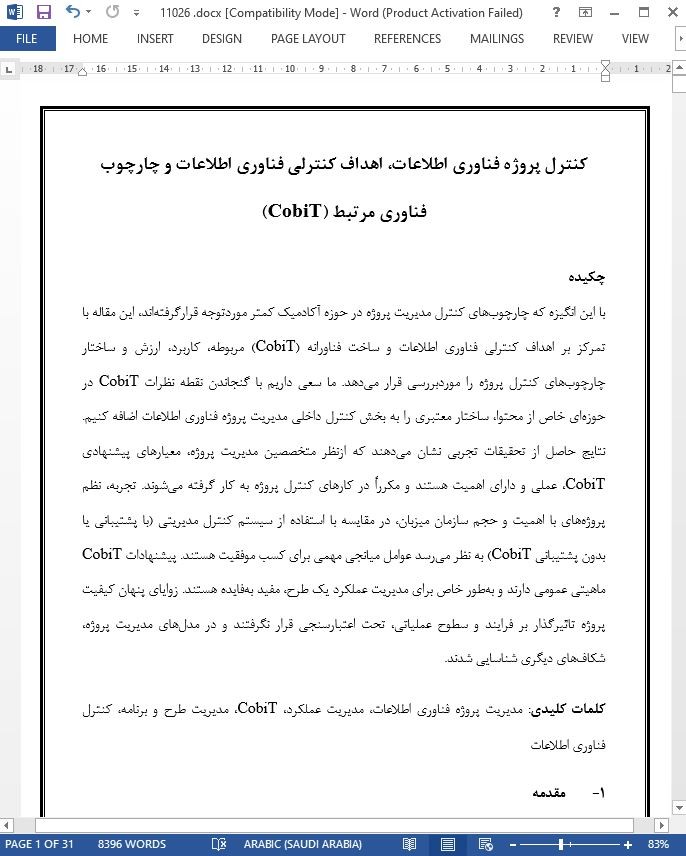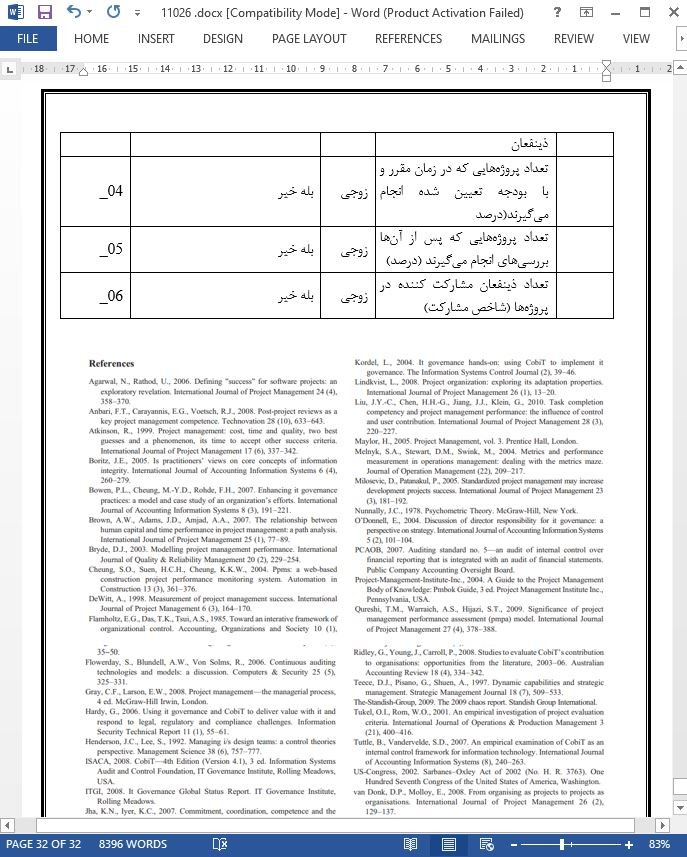
کنترل پروژه فناوری اطلاعات، اهداف کنترلی فناوری اطلاعات و چارچوب فناوری مرتبط (CobiT)
چکیده
با این انگیزه که چارچوبهای کنترل مدیریت پروژه در حوزه آکادمیک کمتر موردتوجه قرارگرفتهاند، این مقاله با تمرکز بر اهداف کنترلی فناوری اطلاعات و ساخت فناورانه (CobiT) مربوطه، کاربرد، ارزش و ساختار چارچوبهای کنترل پروژه را موردبررسی قرار میدهد. ما سعی داریم با گنجاندن نقطه نظرات CobiT در حوزهای خاص از محتوا، ساختار معتبری را به بخش کنترل داخلی مدیریت پروژه فناوری اطلاعات اضافه کنیم. نتایج حاصل از تحقیقات تجربی نشان میدهند که ازنظر متخصصین مدیریت پروژه، معیارهای پیشنهادی CobiT، عملی و دارای اهمیت هستند و مکرراً در کارهای کنترل پروژه به کار گرفته میشوند. تجربه، نظم پروژههای با اهمیت و حجم سازمان میزبان، در مقایسه با استفاده از سیستم کنترل مدیریتی (با پشتیبانی یا بدون پشتیبانی CobiT) به نظر میرسد عوامل میانجی مهمی برای کسب موفقیت هستند. پیشنهادات CobiT ماهیتی عمومی دارند و بهطور خاص برای مدیریت عملکرد یک طرح، مفید بهفایده هستند. زوایای پنهان کیفیت پروژه تاثیرگذار بر فرایند و سطوح عملیاتی، تحت اعتبارسنجی قرار نگرفتند و در مدلهای مدیریت پروژه، شکافهای دیگری شناسایی شدند.
1- مقدمه
از آنجائی که سازمانهای دنیا همیشه سعی بر کسب مزیت رقابتی داشتهاند، پروژههای دارای عملکرد موردقبول و سازمانهای پروژهای ایجاد شده، ابزار اصلی برای رسیدن به اهدافشان هستند (لیندکویست ،2008؛ فان دانک و مولوی ،2008). کنترل مدیریتی پیشرفت پروژه در چرخه عمر پروژه، دارای اهمیتی فزاینده است. یافتههای اخیر نشان میدهند که کنترل پروژه بر کارائی تکمیل پروژه و متعاقب آن عملکرد مدیریت پروژه تأثیر دارد. (لئو و همکاران،2010). کنترل مدیریتی داخلی، تلاشی مهم در جهت بهبود رفتار کارکنان است بهطوریکه باعث حصول تهداف سازمانی میشوند.. (فلمهولتز و همکاران،1985). مطالعه هندرسون و لی (1992) ارتباط مثبتی بین میزان بهکارگیری کنترل مدیریتی و عملکرد مدیریت پروژه نشان داد. در مدیریت پروژههای سنتی، مدیران با توجه به برنامهها و بودجهبندیها پیشرفت پروژه را پایش میکنند. رویکردهای معاصرتر، در سطوح و مراحل مختلف فرایند پروژه، متغیرهای مختلف کنترلی را در نظر میگیرند بهعنوانمثال همکاری کاربران، کارآمدی گروه جهت تکمیل پروژه و عملکرد فردی تیم پروژه. (لئو و همکاران،2010).
7- نتیجه گیری
برای تحقیقات دانشگاهی درباره سیستمهای کنترل پروژه فناوری اطلاعات و اثربخشیشان پتاسیل قابل توجهی وجود دارد تا از این طریق ارزش آنها برای سازمانها مشخص شود. در این مقاله ما بررسی کردیم که ببینیم آیا چنین سیستمهای کنترلی مورد استفاده قرار میگیرند و اینکه ایا متغیرهای کنترل معتبر هستند و در عملیات کنترل مدیریت پروژه به کار گرفته میشوند؟ این تحقیق با پرسش انتقادی، اهداف کنترل فناوری اطلاعات و چارچوب فناوری مرتبط (CobiT) - یک چارچوب پرطرفدار است که برای اهداف کنترل فناوری اطلاعات در دنیا به کار گرفته می شود-آغاز شد.
Abstract
Motivated by scarce academic consideration of project management control frameworks, this article explores usage, value and structure of frameworks with a focus on the popular Control Objectives for IT and related Technology (CobiT) construct. We attempt to add to an empirically validated structure of internal control over IT project management by including CobiT's views on the intended domain of content. Results from the empirical survey indicate that the metrics suggested by CobiT are regarded as feasible and important by project management professionals, and are regularly used in controlling practice. Experience, regularity of significant projects and the size of the hosting organisations, however, seem to be stronger moderators of success rates than the use of a management control system with or without support of CobiT. CobiT's suggestions are of generic nature and in particular useful for programme performance management. The latent dimensions of project quality on process and activity levels were not validated and gaps to other project assessment models were identified.
1. Introduction
As organisations worldwide constantly strive for competitive advantage, major tools in pursuing their objectives are well functioning projects and resulting project organisations (Lindkvist, 2008; van Donk & Molloy, 2008). Management control of project progress throughout their lifecycles is becoming increasingly recognised for its importance. Recent findings highlight that management control influences task completion competency and, thus, project management performance (Liu et al., 2010). Internal management control is seen as an attempt to optimise employee behaviour in a way that allows the achievement of organisational goals (Flamholtz et al., 1985). Henderson and Lee's (1992) study revealed a positive relationship between the adoption rates of management control and project management performance. In traditional project management, managers concentrate on monitoring project progress against schedules and budgets. More contemporary approaches embrace a variety of variables of control at different levels and stages of the project process, e.g., user contributions, project team task completion competency, and individual project team's performance (Liu et al., 2010).
7. Summary and conclusions
Considerable potential exists for academic research to evaluate IT project management control systems and their effectiveness to determine value for organisations. In this paper we set out to see whether such control systems are used and if control variables are valid, important and used in project management controlling practice. The set-up of this research was guided by critically questioning suggestions from the Control Objectives for IT and related Technology (CobiT) framework, a popular framework used worldwide for IT controlling purposes.
چکیده
1- مقدمه
2- چارچوب نظری
1-2 اندازهگیری میزان موفقیت پروژه
2-2 کنترل مدیریتی بر روی پروژهها و CobiT
3- روش تحقیق
1-3 مرور اجمالی
2-3 طرح جمعآوری داده
3-3 نمایه مشارکتکنندگان (پاسخدهندگان به پرسشنامه)
4-3 تحلیل داده
4- چشمانداز مقایسهای CobiT
5- مروری بر چارچوبهای کنترلی
6- بررسی معیارهای فردی
7- نتیجه گیری
Abstract
1. Introduction
2. Theoretical background
2.1. Measuring project success
2.2. Management control over projects and CobiT
3. Research methodology
3.1. Overview
3.2. Data collection procedure
3.3. Profile of respondents
3.4. Data analysis
4. A comparative view of CobiT
5. View on control frameworks
6. View on individual metrics
7. Summary and conclusions
- اصل مقاله انگلیسی با فرمت ورد (word) با قابلیت ویرایش
- ترجمه فارسی مقاله با فرمت ورد (word) با قابلیت ویرایش، بدون آرم سایت ای ترجمه
- ترجمه فارسی مقاله با فرمت pdf، بدون آرم سایت ای ترجمه



